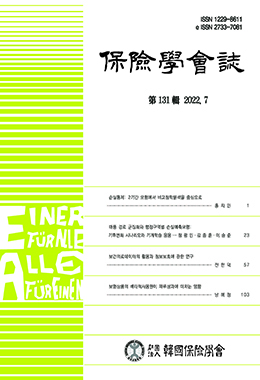본 연구는 한반도에 직접적으로 영향을 주는 태풍의 지역별 손실액 변화를 예측하기 위해 두 단계의 기계학습 접근법을 제안한다. 먼저 태풍의 경로 군집화 분석을 통해 물리적 위태(hazard)를 지역별로 세분화하고, 이를 지리 및 사회경제적 데이터와 결합하여 지역별 손실액을 예측한다. 본 연구에서 제안한 기계학습 기반의 손실 예측 모형(random forest)이 전통적 통계모형(multiple linear regression)과 비교하여 더 나은 예측오차를 보였으며, 일부 사회경제 및 지리적 요인(제방면적, 1인당 지역총소득, 구거면적)이 태풍 손실에 유의미한 영향을 준다는 것을 확인하였다. 기후변화에 관한 정부간 협의체(IPCC)의 시나리오를 고려한 미래시점(2100년)의 한반도 태풍 위험을 예측하고, 행정구역별 위험 요인을 종합적으로 반영한 태풍 위험지도를 제공하였다. 특히, IPCC 시나리오 하에서 예측된 단위 태풍당 경제적 손실은 현 시점 대비 최소 6.5배에서 최대 14.8배 증가하는 것으로 나타났다. 본 연구결과는 (재)보험사에게 기후변화로 인한 재해의 물리적 위태 변화와 관련 손실액을 예측하는 절차적인 방법론을 제공하고 있으며, 이는 시장 공급자들의 적절한 재무 계획 설계 및 기후위험에 대한 선제적 대응에 도움을 줄 것으로 기대한다.
This study proposes a two-step machine learning approach to predicting economic damage caused by tropical cyclones (TCs) in the Korean Peninsula. We first analyze track clusters of TCs to classify regional physical hazards. We then predict regional TC losses by considering geographic and socio-economic information. Comparing traditional regression model(multiple linear regression), we show better performance of our machine learning-based model than the traditional linear model. We also determine that some economic and geographic factors (i.e. embankment, local income per capita, artificial water) are statistically significant in explaining TC losses. We further predict the economic loss per TC in the year 2100 under a climate change scenario of the Intergovernmental Panel on Climate Change(IPCC) and provide a TC risk map on a regional basis. We find in this prediction that the projected losses per TC can be 6.4 to 14.8 times larger than those at present. Our findings can provide (re)insurers with a stepwise process for predicting climate change-driven TC losses can help them for better financial management and proactive responses to climate changes.




